Berita & analisis pasar
Tetap selangkah lebih maju di pasar dengan wawasan ahli, berita, dan analisis teknikal untuk memandu keputusan trading Anda.

Artificial intelligence stocks have begun to waver slightly, experiencing a selloff period in the first week of this month. The Nasdaq has fallen approximately 2%, wiping out around $500 billion in market value from top technology companies.

Palantir Technologies dropped nearly 8% despite beating Wall Street estimates and issuing strong guidance, highlighting growing investor concerns about stretched valuations in the AI sector.
Nvidia shares also fell roughly 4%, while the broader selloff extended to Asian markets, which experienced some of their sharpest declines since April.
Wall Street executives, including Morgan Stanley CEO Ted Pick and Goldman Sachs CEO David Solomon, warned of potential 10-20% drawdowns in equity markets over the coming year.
And Michael Burry, famous for predicting the 2008 housing crisis, recently revealed his $1.1 billion bet against both Nvidia and Palantir, further pushing the narrative that the AI rally may be overextended.
As we near 2026, the sentiment around AI is seemingly starting to shift, with investors beginning to seek evidence of tangible returns on the massive investments flowing into AI, rather than simply betting on future potential.
However, despite the recent turbulence, many are simply characterising this pullback as "healthy" profit-taking rather than a fundamental reassessment of AI's value.
Supreme Court Raises Doubts About Trump’s Tariffs
The US Supreme Court heard arguments overnight on the legality of President Donald Trump's "liberation day" tariffs, with judges from both sides of the political spectrum expressing scepticism about the presidential authority being claimed.
Trump has relied on a 1970s-era emergency law, the International Emergency Economic Powers Act (IEEPA), to impose sweeping tariffs on goods imported into the US.
At the centre of the case are two core questions: whether the IEEPA authorises these sweeping tariffs, and if so, whether Trump’s implementation is constitutional.
Chief Justice John Roberts and Justice Amy Coney Barrett indicated they may be inclined to strike down or curb the majority of the tariffs, while Justice Brett Kavanaugh questioned why no president before Trump had used this authority.
Prediction markets saw the probability of the court upholding the tariffs drop from 40% to 25% after the hearing.
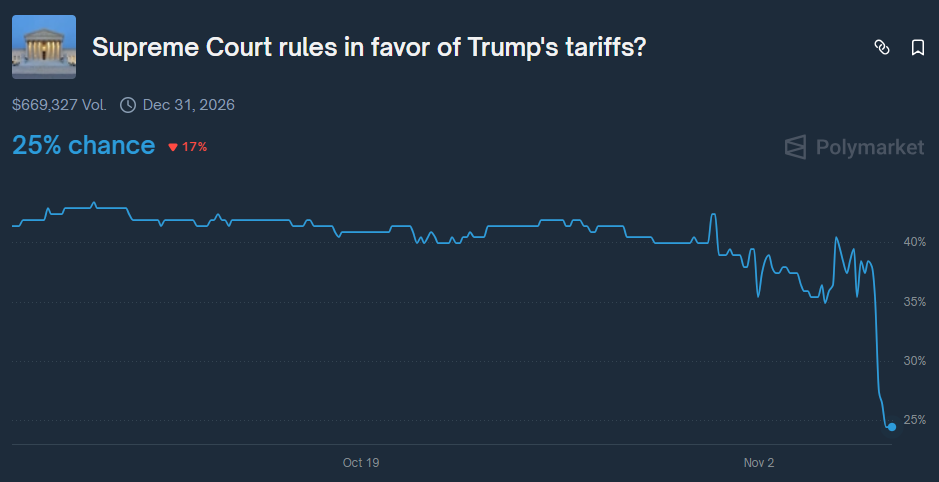
The US government has collected $151 billion from customs duties in the second half of 2025 alone, a nearly 300% increase over the same period in 2024.
Should the court rule against the tariffs, potential refunds could reach approximately $100 billion.
The court has not indicated a date on which it will issue its final ruling, though the Trump administration has requested an expedited decision.
Shutdown Becomes Longest in US History
The US government shutdown entered its 36th day today, officially becoming the longest in history. It surpasses the previous 35-day record set during Trump's first term from December 2018 to January 2019.
The Senate has failed 14 times to advance spending legislation, falling short of the 60-vote supermajority by five votes in the most recent vote.
So far, approximately 670,000 federal employees have been furloughed, and 730,000 are currently working without pay. Over 1.3 million active-duty military personnel and 750,000 National Guard and reserve personnel are also working unpaid.
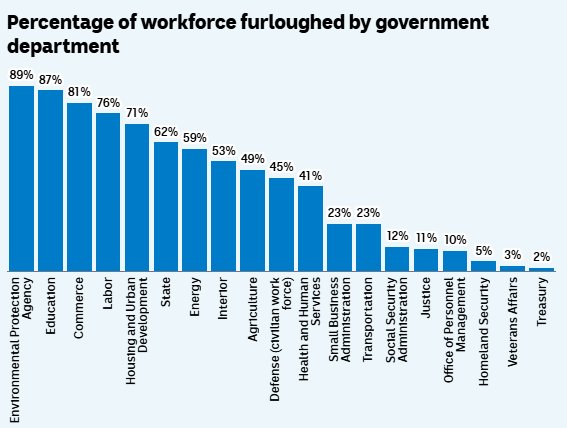
SNAP food stamp benefits ran out of funding on November 1 — something 42 million Americans rely on weekly. However, the Trump administration has committed to partial payments to subsidise the benefits, though delivery could take several weeks.
Flight disruptions have affected 3.2 million passengers, with staffing shortages hitting more than half of the nation's 30 major airports. Nearly 80% of New York's air traffic controllers are absent.
From a market perspective, each week of shutdown reduces GDP by approximately 0.1%. The Congressional Budget Office estimates the total cost of the shutdown will be between $7 billion and $14 billion, with the higher figure assuming an eight-week duration.
Consumer spending could drop by $30 billion if the eight-week duration is reached, according to White House economists, with potential GDP impacts of up to 2 percentage points total.


The overall risk appetite in the market has increased this week following the news that the banking sector’s issues appear to have been resolved. As a result, the Japanese Yen’s status as a safe haven currency may have been hurt in this risk-on market environment. Paired with the renewed recovery in strength in the DXY, this has led to the USDJPY bouncing off the key support and round number price level of 130 to trade steadily higher.
This move higher was sustained as the price broke through the descending trendline, with the USDJPY rising toward the 133-round number resistance level, which coincides with the 38.2% Fibonacci retracement level and 100-period moving average (MA). While the USDJPY could retrace briefly at this resistance area, look for the USDJPY to break beyond the 133 resistance level and 100 MA to signal a continuation of the upward move, with the next resistance level of 135 and the 61.8% Fibonacci retracement level a possible target level. However, watch out for the developing news from the Bank of Japan (BoJ) following recent comments that the BoJ could tweak the current Yield Curve Control (YCC) if the economic and price conditions justify phasing out stimulus.
Widening of the target level or removal of the YCC could lead to a significant strengthening of the Japanese Yen.


The USDJPY had been trading steadily higher in February, from the 128.50 support level, up toward the 137 round number resistance level. This move was driven by a combination of fundamental reasons (strengthening of the DXY and overall weakness of the Japanese Yen) and technical setup (the golden cross, where the 50-period Moving Average crossed over the 200-period Moving Average). This week, the Bank of Japan (BoJ) is set to release its latest decision on its Policy Rate and the accompanying Monetary Policy Statement.
The BoJ is expected to persist with its current stance, maintaining an ultra-lose monetary policy approach as it is the last BoJ policy meeting for Governor Kuroda. However, last week, the yield on the 10-yr Japanese Government Bonds (JGBs) consolidated slightly above the 0.5% ceiling adjusted by the BoJ on 20th December 2022. Following the announcement of the increased yield limit, the Japanese Yen strengthened significantly, with the USDJPY trading down from 137.30 to 130.60.
The markets are now watching if the BoJ would take on a similar action again. As the DXY weakened toward the end of the week, the USDJPY was dragged lower, reversing from the 137 resistance level, down to the 135.80 price level to test the 50-period Moving Average. If the price breaks below the Moving Average support level, the USDJPY could trade down to the key support level of 134.50 which coincides with the 38.3% Fibonacci Retracement level.
If the BoJ were to further adjust the yield limits on the 10-yr JGBs, the USDJPY could see a continuation of the downside beyond 134.50, with the next key support level at the 133 price area, formed by the round number and 61.8% Fibonacci Retracement level.
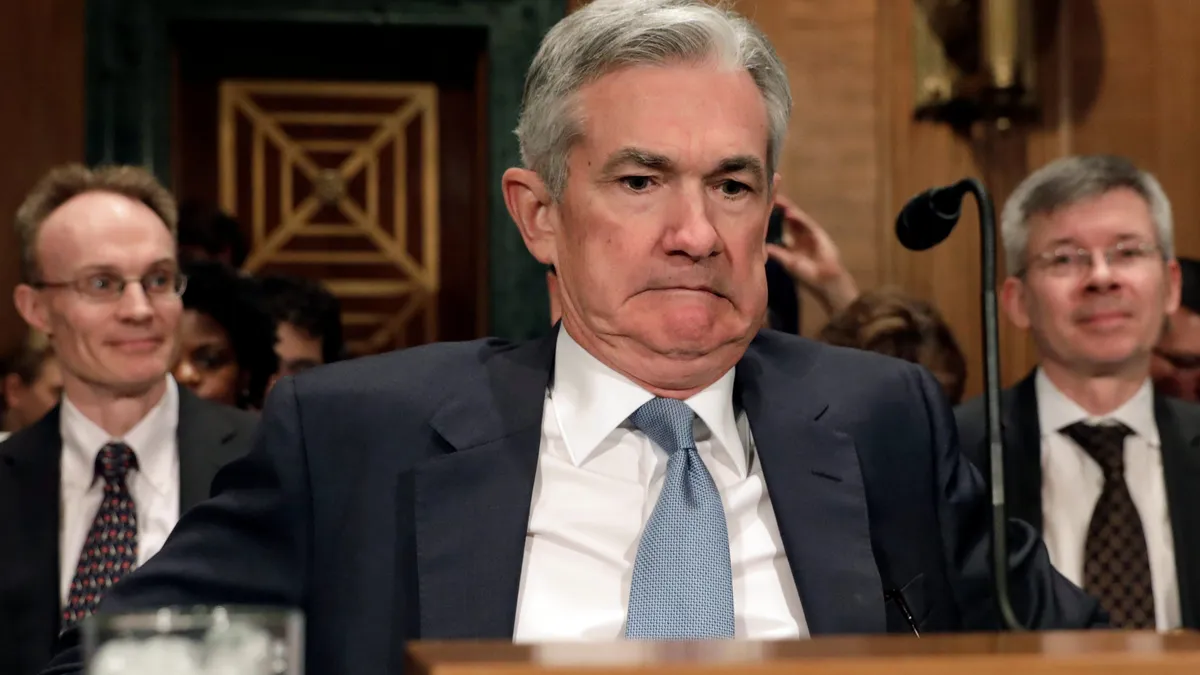

Todays FOMC rate decision is certainly in play, with recent turmoil in the banking sector caused in no small part by aggressive Fed hikes over the last 12 months, throws a very big spanner in the works of the Feds plan to combat inflation. Up until a couple of weeks ago a 50bp hike was pretty much fully priced in as the Fed refused to budge on their aggressive rate hiking path, with the statement released at their last meeting indicating that rates would remain “higher for longer” and fully opening the door to more 50bp hikes in subsequent meetings. This all turned very quickly on the collapse of SVB, quickly followed by Signature banks and Credit Suisse with markets racing to you reprice rate expectations, with the terminal rate predictions coming down to significantly followed by a series of rate cuts into year end, before these banking issues no cuts were priced in at all until 2024.
This dramatic change can be seen in the screenshot below of Pre-Bank issues Fed Fund futures pricing, compared to Fed Fund futures pricing after. All that said, this sets todays meeting up to be the most pivotal Fed meeting since the start of their rate hiking cycle 12 months ago and will almost certainly see big volatility on the announcement and some possible great trading opportunities. Let’s go through the 3 likely scenarios as I see them and what reactions in the market we could see.
Dovish- Possible Against the background of a banking crisis that for now seems contained but could certainly re-escalate. The Fed could also see these banking stresses as de facto tightening of financial conditions and elect to pause rates for now to give the banking sector time to stabilise. This scenario would see no hike and probably an acknowledgement that inflation was too high and future rate hikes were “likely appropriate” but with the impact of recent events need to be assessed first.
Likely FX Market Reaction Likely a very fast move down in the USD on the rate decision, followed by volatility as the statement was being digested, the trend of the USD after that will be how dovish the market sees the Feds comments are and clues at further rate moves. After a hawkish ECB who hiked 50bp last week, this would likely see EURUSD pushing to the resistance zone around 1.08, a dovish statement should see this level hold as support and a further push higher in EURUSD in the coming days. Neutral/Hawkish – Base Case With a still hawkish ECB, hiking 50bp last week and tough talking from it’s members since, the Fed may feel emboldened to see their fight against inflation as their number 1 priority, albeit at a slower pace than previously communicated to the market.
For the Fed to pause here would almost be an admission of bad policy and would likely shake the market more than the fairly contained bank failures we have seen up to this point. This scenario, which I think is the most likely will see the Fed hike by 25bp while stating ongoing rate hikes will be “likely appropriate” but also moderating a bit with saying they will be “data dependant” Inflation wise, I expect language like inflation is still “unacceptably high, but risks are moderating”. Likely FX Market Reaction A modest move higher in the USD on the rate decision, markets are pricing in a 85% chance of a 25bp hike, so the up move will be muted.
The statement will decide how the USD moves after that, if they do include the language outlined above (unacceptably high inflation, ongoing hike likely) then a push lower in EURUSD is likely, first to test it’s recent support level at 1.0760, a break of that would likely see it head towards the big figure support at 1.07 and liekly range around that level for the remainder of the session. Very Hawkish – unlikely The final scenario would be seen as very Hawkish and is probably unlikely against the back drop of recent stress in the financial markets. This would see a 50bp hike with a statement that ongoing rate hikes will be “appropriate”.
On inflation “inflation is unnacceptably high, with risks weighted to the upside” FX Market Reaction A 50bp hike would see an instant, and large reaction in the USD as markets would have to reprice their whole prediction of the rate curve going forward, this would certainly see the EURUSD gap straight past the 1.0760 support and really test the 1.07 before a retracement as the statement is deciphered, continued hawkishness in the statement would would likely see a strong break of the 1.07 level as well. Whatever of the 3 possible paths above the FOMC takes, a mixture of them or something completely from left field, the market is sure to see some big volatility, so trade accordingly and be prepared!
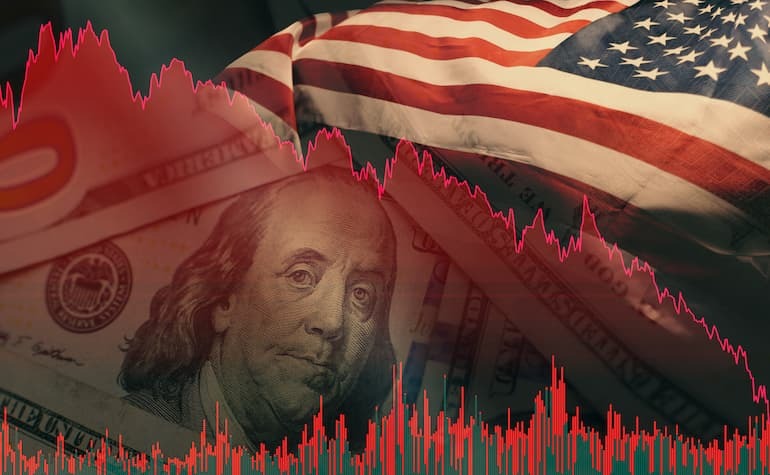

On Thursday last week, the US Federal Reserve met general market expectations by hiking rates by 25bps, taking interest rates in the US to 5.00%. While there was some speculation over a possible slowdown in the rate hikes due to the banking crisis, the decision by the Federal Open Market Committee (FOMC) to hike rates for the ninth consecutive time saw the DXY spike down to test the round number support level of 102. During the press conference, Chair Powell indicated that the FOMC was committed to bringing inflation down to its target level of 2-3% but also warned that there was still significant downside risk to growth.
The DXY consolidated briefly along the 102 key support level but saw a strong correction to the upside toward the end of the week. Currently, the momentum to the upside on the DXY has been halted by the 103.50 resistance level which coincides with a confluence of Fibonacci Retracement levels of 50% in the shorter term and 38.2% from the longer term downtrend. With the US Final GDP q/q and the Core PCE Price index, due to be released this week, with the data expected to signal a slowdown in inflation growth which could reignite the speculation of a slowdown in future rate hikes.
Therefore, if the price maintains below the 103.50 resistance level, the DXY could reverse and continue with the downtrend, to retest the 102 key support level. If the price breaks below 102 the next key support level is at 100.80.


Bank of England Headline February inflation in the UK came at a hotter than expected 10.4%, well above the consensus of a drop to 9.9% and indicating that Januarys dip to 10.1% seems to have been temporary. Unwelcome news for the BoE who have a rate meeting today, before this figure the decision seemed to be on a knife edge, with the markets pricing in a 50-50 chance of a 25bp hike or a hold, those odds have since blown out to make a hike pretty much a done deal with the market pricing in a 90% chance that the BoE will keep the tightening process going. The big change in hike expectations can be seen below, in the Pre CPI vs the Post CPI figures This unsurprisingly saw the GBPUSD rally sharply as the markets repriced the BoE’s actions today, interestingly we can see that the reaction, though a decent move was dwarfed by the volatility seen during and post the FOMC rate decision in this pair.
The UK being a world financial hub means the GBP is especially risk sensitive to financial conditions, whether that is global interest rates, banking stress or threats of global growth slowdowns, the actions of the BoE, while still important have taken a seat to these more macro drivers. With all this in mind the probable 25bp rate hike today will more than likely have a muted first effect on the GBP, the accompanying statement and the voting pattern of the MPC member will be what GBP traders are looking at to get some direction for the session. With the shock of the inflation beat fresh in their minds it’s hard to see the BoE being too dovish but against the current uncertainty in the financial markets I don’t think we’ll see any sustained rally of the GBP after the fact unless there is a real hawkish surprise from the BoE members.
Swiss National Bank Up until recently the SNB meetings have been almost as boring as the Bank of Japan meetings, this has all changed as BoJ the meetings have thrown up surprises and todays SNB against the backdrop of the collapse of Credit Suisse could actually be interesting. The markets are pricing in a 50bp hike from the SNB, despite Swiss banking woes it would be a big surprise if they didn’t go through with this, inflation is rising in Switzerland (jumping unexpectedly to 3.4% last month) and they are a long way behind the curve in respects to other Central Banks with their official rate only sitting at 1%, far behind their peers in Europe and the US. Again the interesting part will be the statement and press conference, where the focus will likely remain on interest rate policy and the banking sector.
CHF may strengthen on the decision but with major support on the USDCHF around the 0.9094 level, any downside on this pair should be limited. The SNB decision is due out at 08:30 GMT with the BoE following at 12:00 GMT
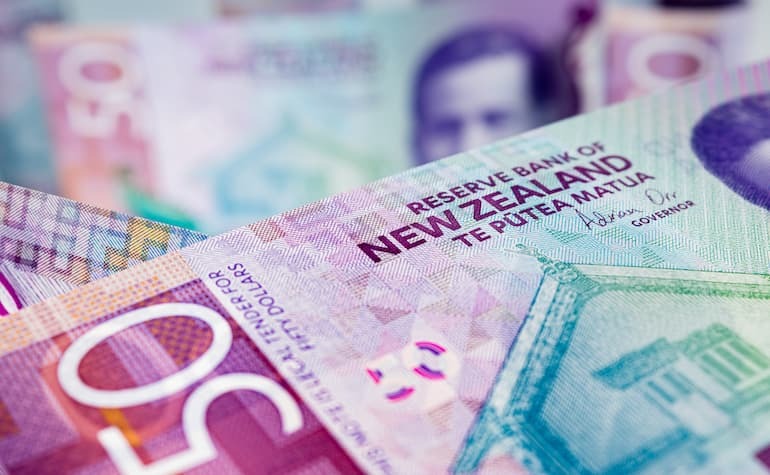

The NZDUSD has been on a decline since the start of February 2023, with the price reversing strongly from the high of 0.6540 ending the previous week bouncing off the 200-day moving average and previous swing low price level of 0.6190. This week, we have the Reserve Bank of New Zealand (RBNZ) due to release their interest rate decision. Current annual inflation in New Zealand stands at a three-decade high of 7.2%, while the quarter-on-quarter data released in January signaled slightly higher than expected CPI growth at 1.4% (Forecast: 1.3%).
This has led the market to anticipate that the RBNZ is likely to hike rates by 50bps, taking rates from 4.25% to 4.75%. If the RBNZ does increase rates by 50bps as expected, this is likely to further strengthen the New Zealand dollar, especially as the NZDUSD had found strong support along the 200-day moving average on Friday. In addition to the interest rate decision possibly driving prices higher, price action on the NZDUSD has also formed a Bullish Regular Divergence with the Relative Strength Index (RSI) at the support level, indicating a further likelihood for the NZDUSD to stage a reversal, to trade higher.
However, for a sustained move to the upside, the price of the NZDUSD would have to break above the near-term resistance area at 0.6270, which also aligns with the 23.60% Fibonacci retracement level. Look for the NZDUSD to rise toward the key resistance and round number level of 0.64, which coincides with the 61.8% Fibonacci retracement level.

